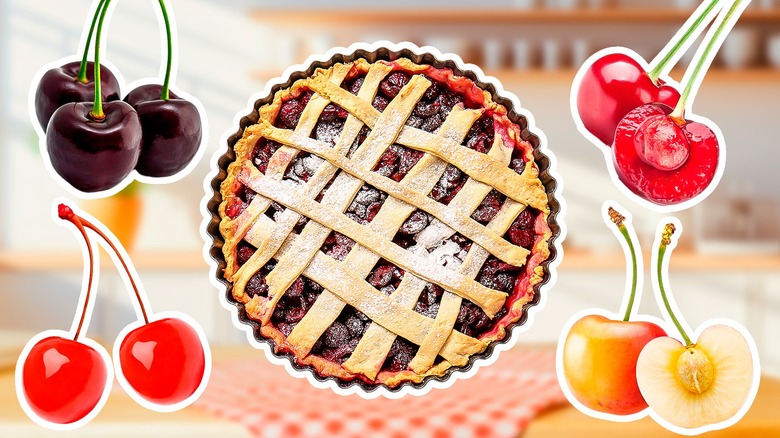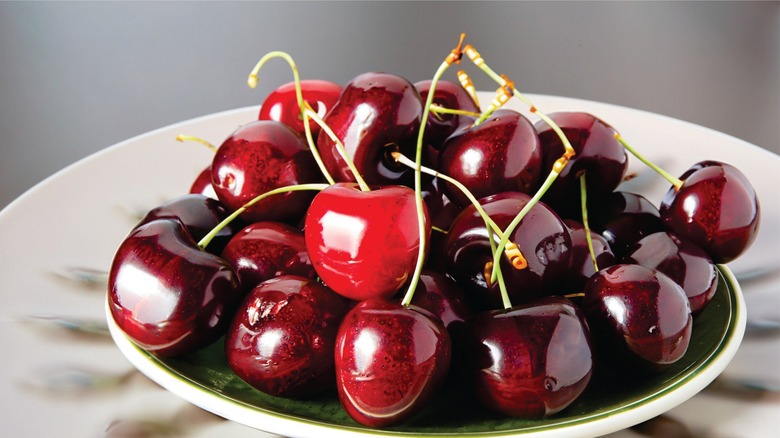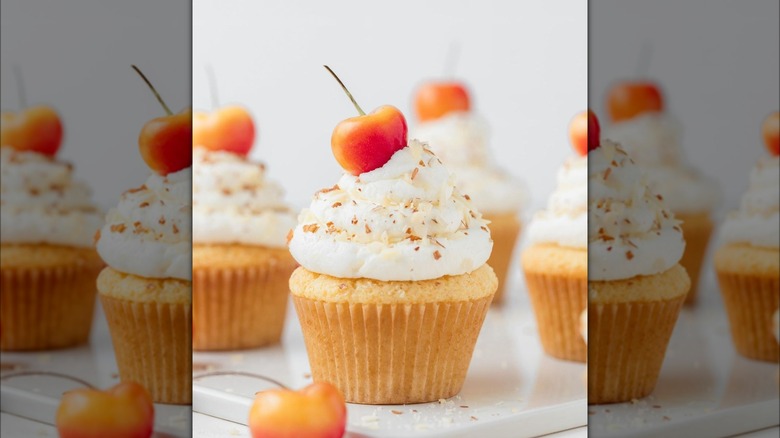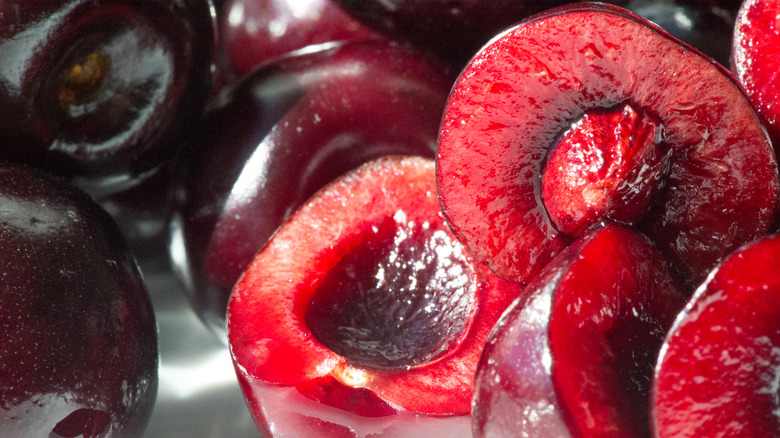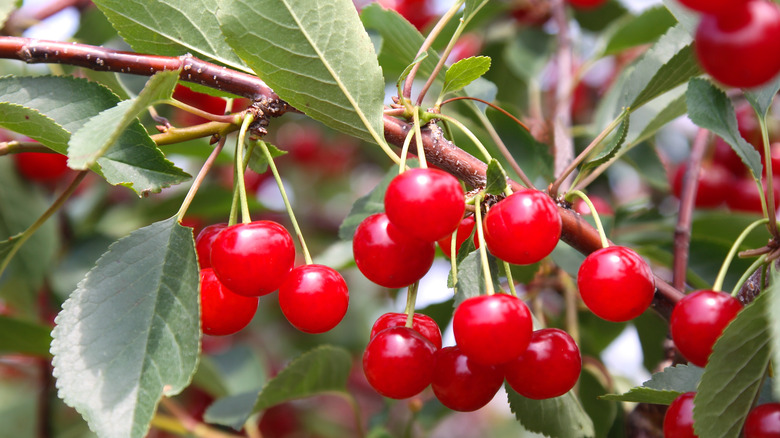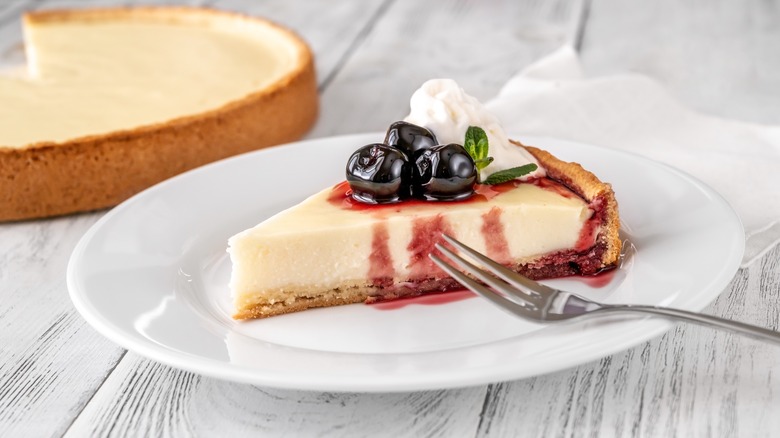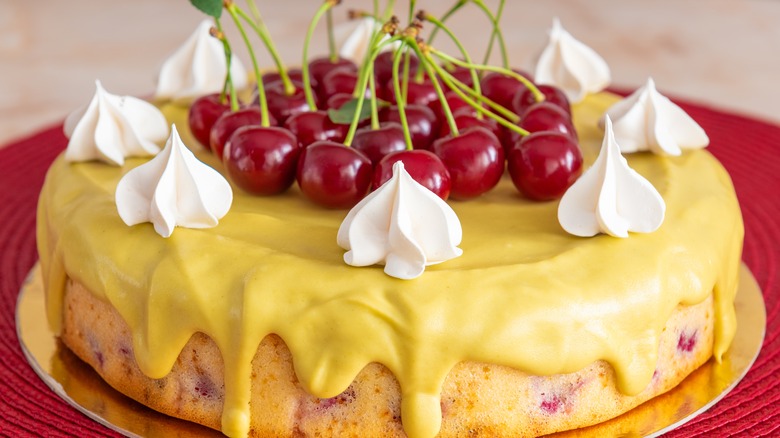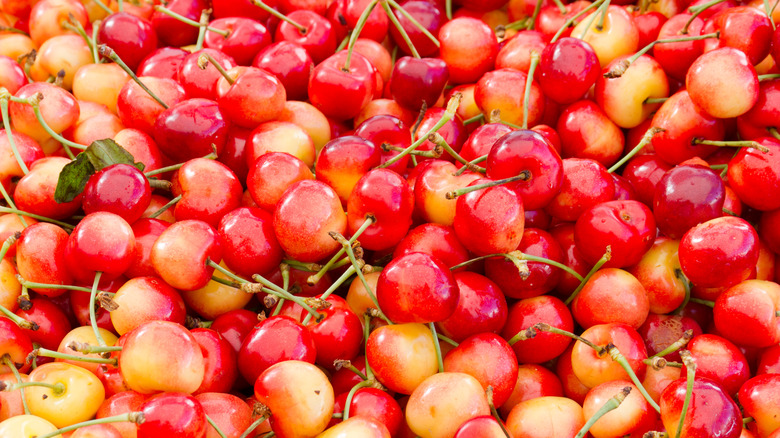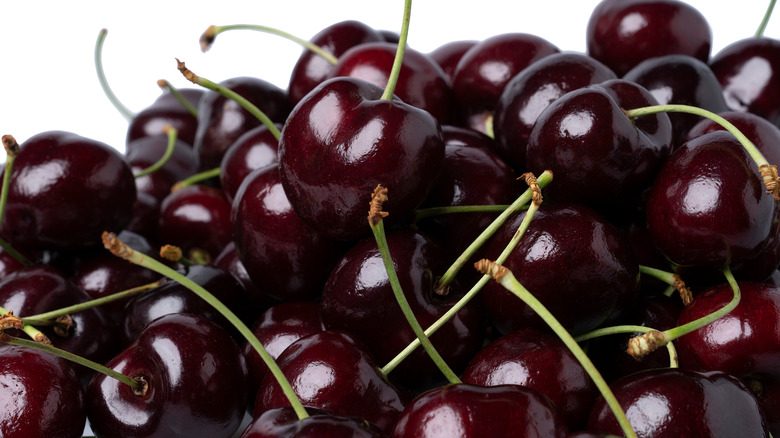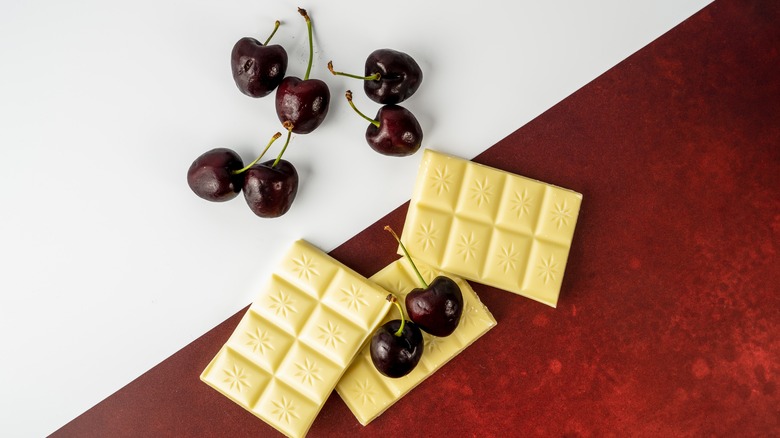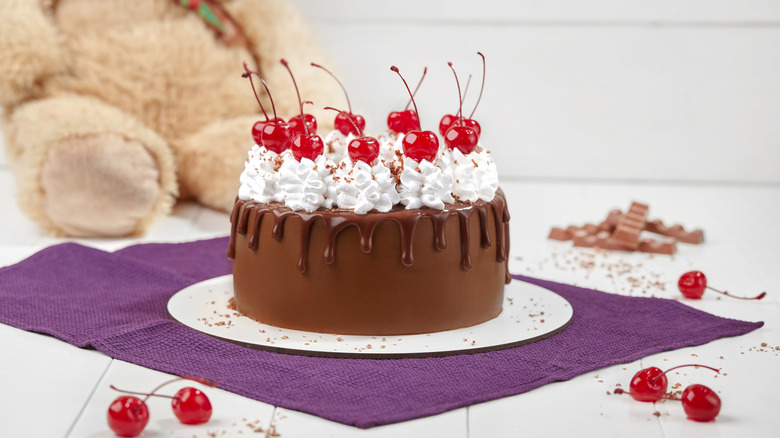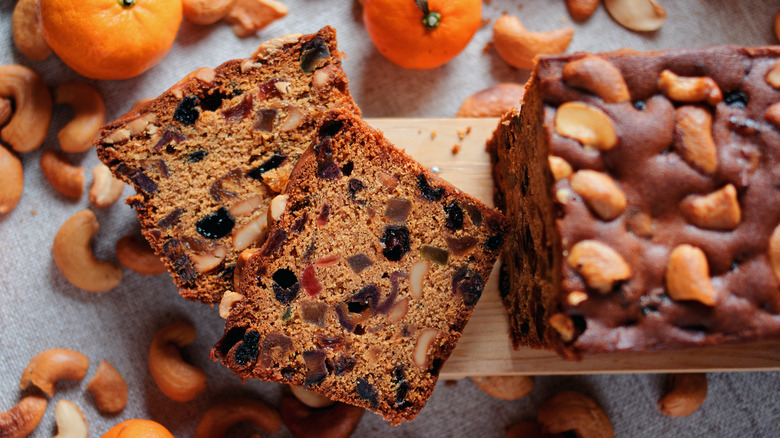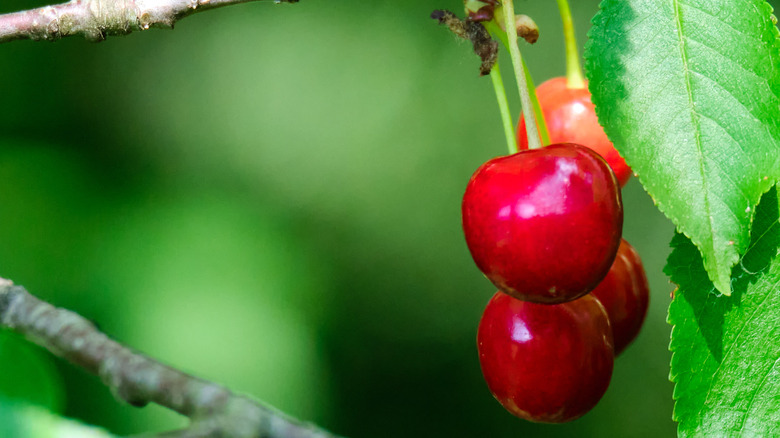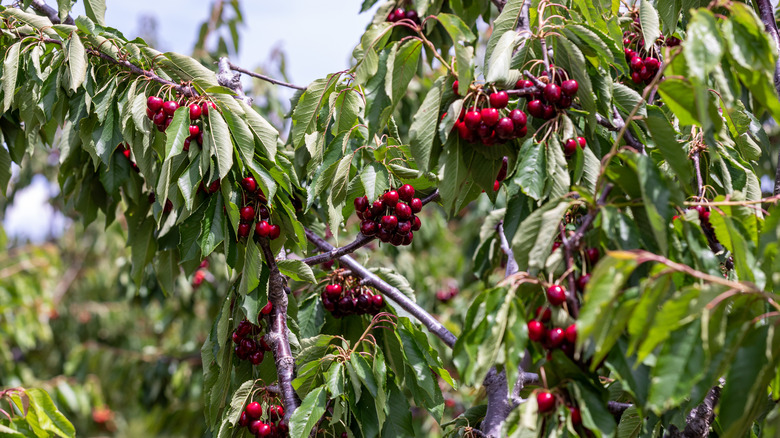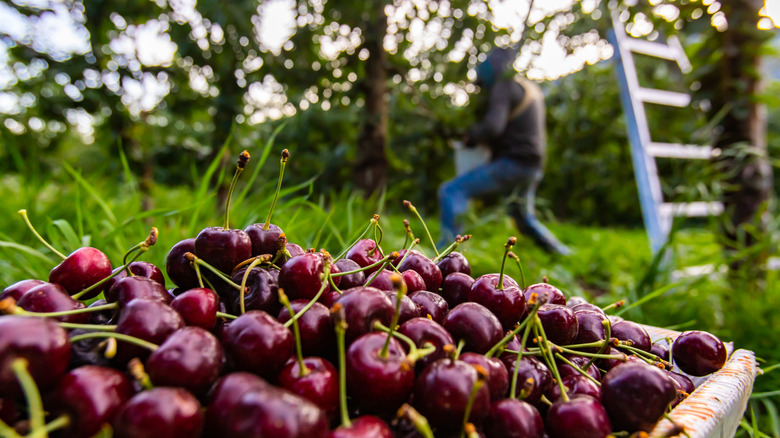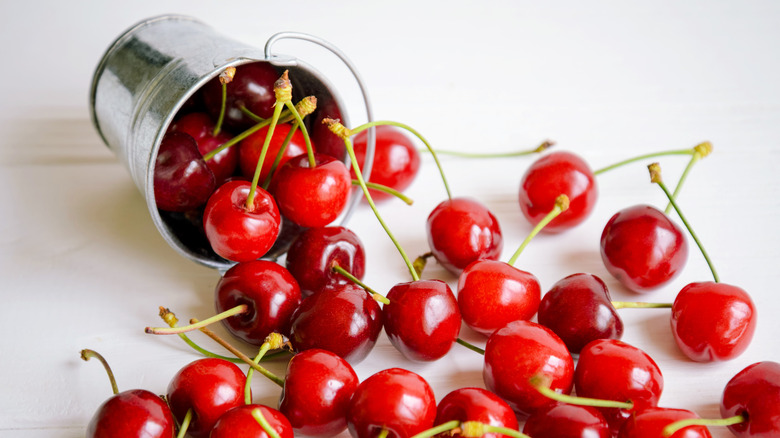The Absolute Best Cherry Varieties For Baking
Summertime is the season for all things fruit. If you open our fridge during June, July, and August, you won't see cubed watermelon, nor will you see peaches and nectarines flooding the crisper drawer so that it barely shuts. Rather, you'll see cherries — and lots of them.
This stone fruit, which resembles a heart-shaped gem, is the pinnacle of summer produce. Grab a handful straight from the bag and pop them into your mouth for a sweet, filling snack; just be sure to keep a plate or a napkin around for spitting out those pesky pits. You can also use them for savory recipes, like for stuffing into meats or making into a cherry chutney to top a pork tenderloin.
But, the real place where cherries stand out is in desserts. It's here where the fruity, juicy flavor meshes with other sweet complements, including nuts, sugar, chocolate, and more. In order to help guide you on which cherry variety (after all, there are over 1,000 out there) will be best for your pie, cobbler, or dessert bars, we've recruited the assistance of baker, recipe developer, and dessert mastermind behind Dollop of Dough, Megan Weimer.
Bing cherries
Bing cherries are one of the most ubiquitous cherry varieties you'll find at a common grocery store. This type of cherry is very round and sturdy, and also is quite juicy — which makes it excellent for snacking as well as cooking. The Bing cherry got its name from the original propagator, Ah Bing, and has had a legacy as one of America's most recognizable stone fruits.
Using this cherry variety comes with a ton of benefits, which is why it's one of the best types of baking cherries out there. "They're sweet, juicy, and have a firm texture, making them ideal for recipes that require a bit of structure, like pies and tarts," explains baker and recipe developer Megan Weimer. She prefers to use Bing cherries in her cherry-infused cinnamon rolls for a bright pop of red color and a sweet, subtle flavor. We also recommend using it for a fresh cherry pie filling because of the fruit's robustness, which will still be decipherable even after the pie is baked.
Rainier cherries
If you take a stroll through the produce aisle in the summer months, chances are that you have probably seen the beautiful, striking Rainier cherry. Each one is like the color of fire, completed with bright orange and red hues. It's one fruit you might feel guilty about eating because of how interesting it is to look at. But, you'd be remiss not to bite into one of these juicy fruits, which have delectable peachy notes and a subtle toffee and caramel-like undertones.
This beauty is also a beast in the kitchen — particularly for baking. Rainier cherries have a remarkably high sugar content, which means that they can be used to subdue the flavors of other, more tart fruits. Megan Weimer also notes that these are great fruits to use when you're looking for something with a more subtle cherry flavor. "Rainier cherries are fantastic in cakes and scones where you want a softer, less tart flavor," she explains. She also suggests whipping up a cherry compote to smother on cheesecake or yogurt.
Tulare cherries
Tulare cherries are, overall, well-rounded fruits. Not only will you get the bright, tart flavor that you love from the stone fruit, but also a subtle bit of sweetness that makes this cherry one you'll want to keep in your fridge for all of your baking needs.
Tulare cherries are an excellent addition to a cobbler or a pie because you can tweak the sweetness by adding in more robustly sweet fruit, like Bing or Morello cherries, or stick to something a bit more tart and adjust with the added sugar as needed. The important thing to note, though, is that the Tulare cherries are not as sturdy and thick-skinned as other varieties. So, if you're looking for clearly defined hunks of cherries in your dessert or pie, you're better off supplementing with other cherry varieties or sticking to making a jam with this one — of which you can add to crumb bars and on the top of scones.
Montmorency cherries
Montmorency cherries are one variety that you might be less familiar with, but they're one you'll want to try for the absolute best cherry pie. Unlike Bing, Amarena, and Rainier cherries, the Montmorency cherries are rather tart. Yet, they're still quite sturdy, so they can readily hold up to baking in the oven. If you prefer sweets that have a solid balance of butteriness, sweetness, and tartness, you can always opt for a more sour cherry, like this one, and play with the amount of sugar or other sweeteners in your recipe to moderate the filling's flavor.
Megan Weimer explains that there are more ways to use this unique cherry than just for pies. "They're perfect for recipes that need a burst of tartness to balance sweetness, such as in cherry jam, sauces, or in combination with chocolate in baked goods," she explains. Imagine how delectable (and visually appealing) your cherry cheesecake would taste with a Montmorency cherry compote on top.
Amarena cherries
If you are familiar with the world of cocktails, you have stumbled across Amarena cherries a time or two. This type of cherry is part of Giada De Laurentiis' trick for putting a spin on old fashioneds, but this artisanal cherry can also be used for more than just beverages. Amarenas are dark in color, which can add some visual depth to your favorite baked goods recipe. But the color isn't the only thing that's striking about this variety. "They're delicious in desserts like chocolate cakes or pastries, where their intense flavor can really shine," explains Megan Weimer. One particular application where this might work well, for example, is in a Black Forest cake, where the distinct cherry notes can play off the chocolate in the sponge.
The important thing to know about Amarena cherries is that they're often packed in syrup. So, to avoid over-sweetening your dessert, you may consider giving them a quick wash under water to remove this coating, or dialing back the other sweet elements of your dessert to avoid overwhelming the palate.
Morello cherries
Morello cherries are one of the up-and-coming varieties in the baking world. These fruits can hold their own when it comes to flavor; you'll find a solid balance of sweet and sour with every bite. So, they're well-suited for recipes where they offer this flavor complexity, such as in a clafoutis. You're likely to find this variety of cherry in a jar, so you'll need to take into account the wetness and flavor of the fruit before you decide on how best to use it.
Another popular use for Morello cherries is in the making of kirsch. So, as a result, the Morello cherry would be a great pairing for sweet applications where you would also use this clear spirit. One such recipe is our sour cherry pie, which infused the spirit into the filling, and complements the boozy addition with frozen sour cherries, Cointreau, and some acidity from the orange juice and lemon zest. It's a great balance for a pie filling that could otherwise lean into a flavor dimension that's far too cloying.
Queen Anne cherries
The Queen Anne cherry certainly rivals the beautiful hue of the Rainier cherry. And no, we're not talking about the delicious brand of cordial cherries — which just happen to share the same name. You'll hear this cherry variety also referred to as Royal Ann.
The big difference between the Queen Anne cherry and the Rainier cherry is that the former is much more aromatic, flavorful, and sweet. Rainiers are already sweet, but this one takes it to a new level. If you decide to use Queen Anne cherries in a pie, you'll still get that beautiful visual contrast between a tart or pie shell and the cherries themselves. You'll also often see these fruits dyed red and placed into a jar, where they quickly become maraschino cherries — but more on that later. In the meantime, the fresh version of this fruit is an excellent contender for an array of baking applications, but we think it's best when its color and flavor are highlighted.
Kordia cherries
It would be rather easy to mistake a Kordia cherry for a Bing cherry. Gardeners will appreciate this fruit because it appears on the trees in the later summer months, around August, and bears delectable, dark red fruits that are relatively hardy.
As a result, you can use this late-blooming cherry for nearly all the same applications where you would opt for a Bing cherry. One delicious one would be for an almond-spiced cherry cobbler; the prominent sweetness and juiciness of the fruits would be an excellent pairing for the almond-flour-based topping. You could also subdue some of the sweetness by mixing the Kordia cherries with something a bit more tart, like Morellos or even Montmorency, to help subdue some of the cloying flavors. Since these bulbous fruits are also brimming with juice, they would also make for an excellent garnish for your baked goods, including on top of cakes and cupcakes.
Chelan cherries
Chelan cherries are becoming one of the more popular varieties in the store and may be noticed more readily than the more underground varieties. The Chelan cherry is an excellent sweet snacking cherry; the skins are quite crisp and the fruit is juicy, yet still firm. They're also a great baking and cooking fruit because they're harvested earlier in the summer than other varieties. It also is a hardy cherry that is resistant to cracking and breaking open.
While we really enjoy eating Chelan cherries straight from the bag, there are also numerous ways to put this sturdy hybrid fruit to good use and capitalize on its sweetness and overwhelming juiciness for baking. They would be excellent added to a scone, since the sweetness can help round out the blandness of the batter surrounding it. You can also pair it with a complementary flavor, like almond extract, almond flour, or slivered almonds, to add a nutty dimension to the sweet fruit.
Maraschino cherries
Believe it or not, there are more uses for maraschino cherries than just topping an ice cream sundae or dropping into the grandmother of all mocktails: the Shirley Temple. While we wouldn't have the maraschino cherry without the Queen Anne, this cherry's descendant couldn't be any more different than its ancestor. The maraschino was first created as a way to preserve the Queen Anne sans the alcohol; it was instead injected with sugar syrup and red dye to create a fruit as candy-ish as it can be.
This preservation process dramatically changed the color, flavor, and texture of the cherry. The kinds sold in jars are limp, have a much more vibrant color than seems natural, and don't really taste like anything more than "sweet." Since these fruits are so preserved, don't expect them to hold up well inside of a pie or a tart. Instead, you can cut them up into tiny pieces and stir them into muffin and/or brownie batter for a pop of color and a chewy bite.
Dried cherries
Although many people can admit to keeping a container of raisins in their pantry, we'd assume that dried cherries are slightly less popular. The drying process zaps the moisture from the fruits, which in turn makes them rubbery and distinctively raisin-like. You'll see an array of cherry varieties dried, like Montmorency for tart dried cherries and Rainier cherries for sweet ones. As a result, you're going to want to read the label very closely to understand which flavor profile you will encounter when you incorporate them into your baked goods.
One of our favorite uses for dried cherries is in cookies. While fresh cherries would alter the moisture and hydration inside of the finicky batter, the dried cherries will ensure that the cookie stays intact. Include other ingredients like almonds and chocolate in your cookies to give them a flavorful boost and to complement the fruit. You can also use dried cherries for a seasonal fruitcake complemented with rum and ginger.
North Star cherries
North Star cherries are still considered to be tart cherries, but they have a little more reprieve to them than a true, sour cherry. The exact flavor will really depend on when it's harvested and how long it's been allowed to ripen; letting them age before adding them to your baked goods will help them become more sweet and balanced.
The color and structure of the North Star cherry makes it an excellent fit for pies. This compact tree produced fruits that can hold up to the weight of cooking, but also make for excellent juicing or jam-making. One excellent use would be for a cherry crisp; the sugary streusel topping can add some much-needed sweetness to the fruits, which will still be intact underneath when you slide your scoop in. Just be sure to pack on a hefty scoop of vanilla ice cream on top, which will play well into the fruity overtones and hunks of brown sugar and butter in the crisp.
Tieton cherries
Tieton cherries are impressive in size and even more impressive in flavor. This trademarked variety has about the same amount of sweetness as other varieties, like Bing, at around 16% to 18% sugar content. Since the fruits are slightly larger than other varieties, they give users an excellent opportunity to serve them whole and fresh. If you're looking for an easy dessert, for example, you may try just covering a halved or pitted whole fruit in dark chocolate.
Yet, the firm flesh and sublime sweetness of the fruit also lend themselves well to pairing with batters and transforming into something new, along with a little help from your oven. You may try substituting this cherry variety for Bing in your next Black Forest cake. Plus, you can even simplify this recipe by using canned cherry filling and sticking to decorating the top of the cake with sliced Tieton cherries. Or, try whipping up some sweet, single-serve clafoutis by cooking down the batter, studded with cherry pieces, in a muffin tin. Whatever you make, just know that it's bound to be sweet.
Lapins cherries
Lapins cherries are an equally delicious option for all of your baking needs. These self-pollinating trees are relatively robust and share many of the same flavor and textural characteristics as the beloved Bing cherry. They can be easily swapped in for Bings in many of the same recipes, including pies, tarts, cakes, and more.
Since the Lapins cherry is a balanced, sweet-leaning fruit, it makes an excellent addition to muffins and scones. It also meshes well with chocolate, caramel, and nuts, so you may consider taking a gander through your pantry to find some extra ingredients to amp up your recipe. Try pairing the sliced fruit with dark chocolate for a simple muffin recipe, or even consider adding it to your pancake batter to switch up your breakfast routine. Although the fruit is more sweet than tart, it will make for a meal that you can't resist topping with extra maple syrup — for good measure.
Lambert cherries
Lambert cherries have a much brighter red hue and are slightly more recognizable than standard Bing or Morello cherries. The color is certainly dark red, but the fruits aren't as dark and almost-purple in color as some of the aforementioned varieties. The fragrant fruit is brimming with a tantalizing stone fruit aroma and has a juicy texture that's sure to glide over your lips and tastebuds with a refreshing acidity.
You'll notice, like with other cherry varieties, that the flavor of the Lambert turns into something deeper as the fruit is baked. This makes for an excellent pairing for caramel and brown sugar notes, like the ones found in a crisp or a crumb cake. You can easily stud the base of your cake with large chunks of fruit before topping it with a tantalizing, buttery streusel. The fruits will stay juicy, but not leak into the surrounding batter. Just be sure to avoid tossing the fruit too much so that the juice spreads and turns the base of your cake wholly pink.
